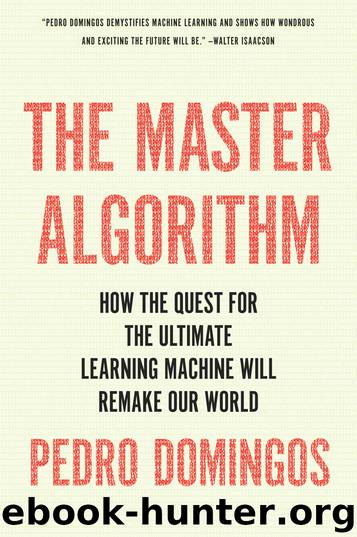The Master Algorithm by Pedro Domingos

Author:Pedro Domingos [Domingos, Pedro]
Language: eng
Format: epub
ISBN: 9780465061921
Publisher: Basic Books
The inference problem
There’s a big snag in all of this, unfortunately. Just because a Bayesian network lets us compactly represent a probability distribution doesn’t mean we can also reason efficiently with it. Suppose you want to compute P(Burglary | Bob called, Claire didn’t). By Bayes’ theorem, you know this is just P(Burglary) P(Bob called, Claire didn’t | Burglary) / P(Bob called, Claire didn’t), or equivalently, P(Burglary, Bob called, Claire didn’t) / P(Bob called, Claire didn’t). If you had the full table with the probabilities of all states, you could obtain both of these probabilities by adding up the corresponding lines in the table. For example, P(Bob called, Claire didn’t) is the sum of the probabilities of all the lines where Bob calls and Claire doesn’t. But the Bayesian network doesn’t give you the full table. You could always construct it from the individual tables, but that takes exponential time and space. What we really want is to compute P(Burglary | Bob called, Claire didn’t) without building the full table. That, in a nutshell, is the problem of inference in Bayesian networks.
In many cases we can do this and avoid the exponential blowup. Suppose you’re leading a platoon in single file through enemy territory in the dead of night, and you want to make sure that all your soldiers are still with you. You could stop and count them yourself, but that wastes too much time. A cleverer solution is to just ask the first soldier behind you: “How many soldiers are behind you?” Each soldier asks the next the same question, until the last one says “None.” The next-to-last soldier can now say “One,” and so on all the way back to the first soldier, with each soldier adding one to the number of soldiers behind him. Now you know how many soldiers are still with you, and you didn’t even have to stop.
Siri uses the same idea to compute the probability that you just said, “Call the police” from the sounds it picked up from the microphone. Think of “Call the police” as a platoon of words marching across the page in single file. Police wants to know its probability, but for that it needs to know the probability of the; and the in turn needs to know the probability of call. So call computes its probability and passes it on to the, which does the same and passes the result to police. Now police knows its probability, duly influenced by every word in the sentence, but we never had to construct the full table of eight possibilities (the first word is call or isn’t, the second is the or isn’t, and the third is police or isn’t). In reality, Siri considers all words that could appear in each position, not just whether the first word is call or not and so on, but the algorithm is the same. Perhaps Siri thinks, based on the sounds, that the first word was either call or tell, the second was the or her, and the third was police or please.
Download
This site does not store any files on its server. We only index and link to content provided by other sites. Please contact the content providers to delete copyright contents if any and email us, we'll remove relevant links or contents immediately.
| Computer Vision & Pattern Recognition | Expert Systems |
| Intelligence & Semantics | Machine Theory |
| Natural Language Processing | Neural Networks |
Algorithms of the Intelligent Web by Haralambos Marmanis;Dmitry Babenko(16319)
Jquery UI in Action : Master the concepts Of Jquery UI: A Step By Step Approach by ANMOL GOYAL(9443)
Test-Driven Development with Java by Alan Mellor(7739)
Data Augmentation with Python by Duc Haba(7615)
Principles of Data Fabric by Sonia Mezzetta(7383)
Learn Blender Simulations the Right Way by Stephen Pearson(7296)
Microservices with Spring Boot 3 and Spring Cloud by Magnus Larsson(7143)
Hadoop in Practice by Alex Holmes(6601)
RPA Solution Architect's Handbook by Sachin Sahgal(6519)
The Infinite Retina by Robert Scoble Irena Cronin(6220)
Big Data Analysis with Python by Ivan Marin(5941)
Life 3.0: Being Human in the Age of Artificial Intelligence by Tegmark Max(5520)
Pretrain Vision and Large Language Models in Python by Emily Webber(4898)
Infrastructure as Code for Beginners by Russ McKendrick(4658)
Functional Programming in JavaScript by Mantyla Dan(4445)
WordPress Plugin Development Cookbook by Yannick Lefebvre(4389)
The Age of Surveillance Capitalism by Shoshana Zuboff(4253)
Embracing Microservices Design by Ovais Mehboob Ahmed Khan Nabil Siddiqui and Timothy Oleson(4149)
Applied Machine Learning for Healthcare and Life Sciences Using AWS by Ujjwal Ratan(4137)
